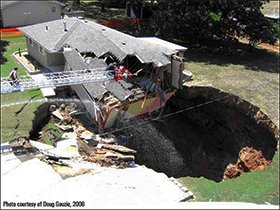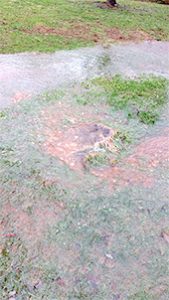In the wake of recent rain events and flooding throughout Missouri, it’s important to think about the increased risk of sinkholes and other hazards following storms. Karst systems, which form within soluble rocks like limestone, are especially affected by sudden significant rainfall. If you live or own property in a karst region, you should be aware of the risks and know how to protect yourself and your property from sinkholes.
Sinkhole collapses are triggered by increases in soil moisture content. Such collapses result from soil failure rather than rock failure, and happen when soil erodes into cavities below. As more and more soil erodes into the cavity, the overlying soil can no longer support itself — and a sudden surface collapse occurs.



A large volume of stormwater can wash out existing sinkholes, greatly increasing their size in a short time. Even if you’re not aware of any history of sinkholes in your area, if you’re in a karst region, be wary. Sinkholes can appear suddenly, and they’re not the only karst-related dangers. Stormwater events can cause blowouts in an existing karst system, effectively creating a new spring where none existed before. These blowouts can exacerbate local flood conditions and, in extreme cases, even establish new rivers or streams surging out of the underground water system.The formation of small surface holesThese changes to karst systems can occur suddenly and, if left uncorrected, can cause significant damage to structures and property. After a storm event, watch your property carefully for telltale signs of karst failures in progress. Any of the following should be warnings of potential danger:
- Resurgence of groundwater in places where it has historically not occurred
- Formation of tension cracks in the soil
- A general subsidence (collapse) or uplifting of the ground surface
Each karst failure is unique. Depending on the situation, remedial measures can include construction of graded filters, chemical or cement grouting, or construction of reinforced concrete caps. Consult a professional as soon as possible to limit damage.
It’s impossible to completely eliminate the danger associated with sinkholes and other karst stormwater events. But by becoming aware of the potential threats, carefully monitoring property during heavy rainfall, and quickly seeking professional help when necessary, you can reduce your risk and protect yourself and your property.